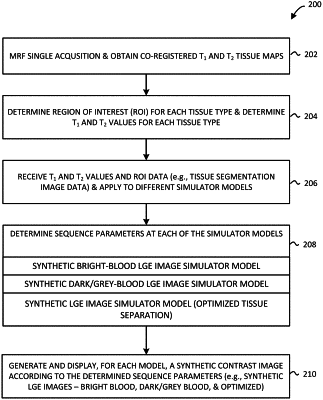| CPC G01R 33/5608 (2013.01) [A61B 5/0044 (2013.01); A61B 5/055 (2013.01); G01R 33/483 (2013.01); G01R 33/50 (2013.01)] | 22 Claims |

|
1. A method for synthetic late gadolinium enhancement imaging, the method comprising:
receiving, by one or more processors, magnetic resonance fingerprinting (MRF) image data of a subject from a scanning device and obtaining, from the MRF image data, a T1 tissue property map and a T2 tissue property map co-registered with the T1 tissue property map;
identifying, using the one or more processors, a plurality of regions of interest in the MRF image data, the plurality of regions of interest comprising at least one myocardium region and a blood region;
determining, by the one or more processors, T1 and T2 values for each of the plurality of regions of interest;
determining, by the one or more processors and based on the T1 and T2 values for the plurality of regions of interest, a plurality of different sets of pulse sequence parameters, each set of pulse sequence parameters being configured to correspond to a different image contrast condition; and
generating, by the one or more processors, a different contrast image for each of the different sets of pulse sequence parameters, wherein at least one contrast image is a synthetic bright-blood LGE image, at least one contrast image is a synthetic dark-blood/gray-blood LGE image, and at least one contrast image is a synthetic LGE image generated by numerically optimizing a contrast between different tissue types from among the plurality of regions of interest.
|